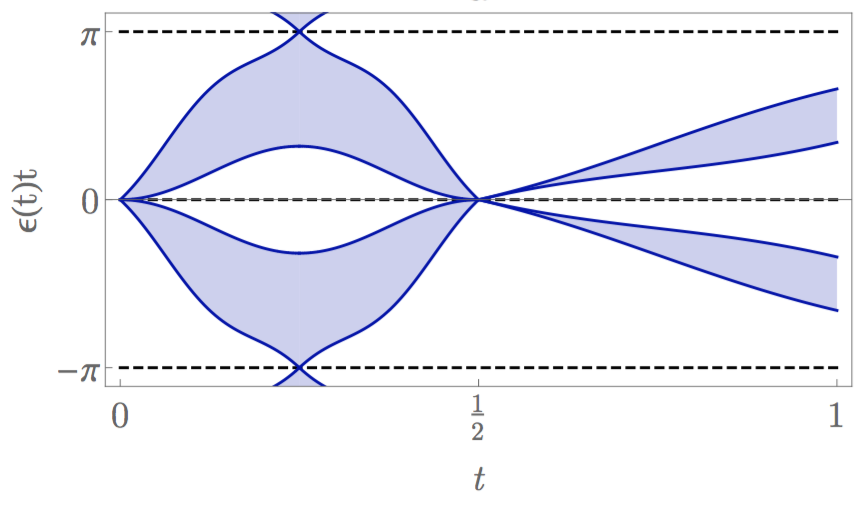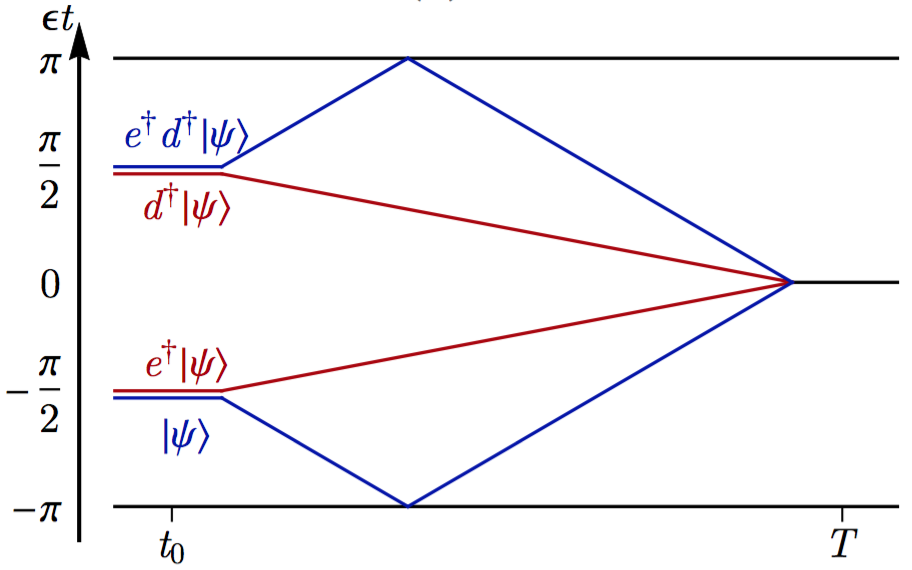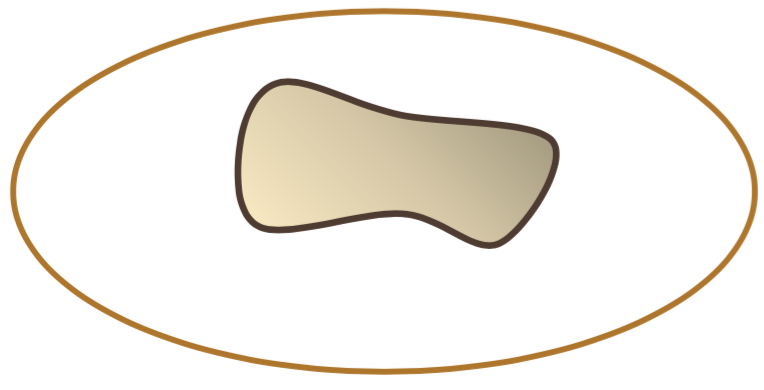Driven Quantum Systems
Click here to expand all sections.

of a Thouless pump
Overview of Driven Quantum Systems
The introduction of time dependence into a quantum system can dramatically increase the complexity of the problem. In such dynamical systems, traditional concepts from equilibrium physics, such has the notion of a ground state, are no longer useful. Instead, an understanding of these systems—and even the notion of a 'phase' away from equilibrium— requires fundamentally different theoretical approaches. On the other hand, dynamical systems offer the chance to generate exotic new phases that cannot exist in static systems. Many such phases are directly accessible in the laboratory—where lasers and modulated electromagnetic fields may be used to drive a system out of equilibrium.
Topological Phases of Free Fermions in Floquet Systems

into loop and constant components
A central principle that arises in the study of topological insulators is holography: the idea that the properties of a bulk topological phase are manifested on the boundaries of the system. This bulk-edge correspondence is neatly summarised in the celebrated periodic table of topological insulators and superconductors (TIs) [11], which classifies the bulk invariants (and associated edge modes) that may exist in a topological phase of free fermions. Notably, the edge modes of a TI in d dimensions are anomalous: the Hamiltonian that describes the physics at the boundary cannot be generated in a d-1 dimensional system. In [8] we investigated similar holographic principles in driven systems of free fermions, uncovering several new driven topological phases and unifying previous work in this field.

in Class D
Symmetry Protected Topological phases (SPTs) in Floquet Systems
In the presence of both symmetry and interactions, a rich set of topological states, known as symmetry protected topological phases (SPTs), is known to exist. A complete classification of these systems has not yet been obtained in full generality, but there is considerable confidence in the classification of static bosonic systems in one to three dimensions [18]. A natural question to ask is how this classification changes if we allow the system to vary with time. Are there new phases that are inherently dynamical in nature? The new driven phases of free fermionic systems [8] and some early work on interacting systems [9] suggested that this is indeed the case. Our group was one of a number of groups [10,19–21] to provide a complete classification of time-dependent Abelian SPT phases in one dimension

of an adiabatic cycle
Adiabatic Cycles
In contrast to Floquet systems, where driving occurs at a single, often high, frequency, we can also consider the slow evolution of a system over one complete cycle. An adiabatic cycle is an evolution of this kind that maintains any bulk gaps that are present in the initial Hamiltonian. Even under these simplifying assumptions, Thouless showed that nontrivial physics can arise when the cycle is completed [24]—for example, a nontrivial Berry phase may be picked up, corresponding to a pumped unit of charge. In the presence of symmetries, preserved throughout the evolution, adiabatic cycles may have more general effects. In Ref. [25] we studied adiabatic cycles in the ten AZ symmetry classes in all dimensions and uncovered a number of new, interesting types of pump in one and higher dimensions.
References
[1] J. Cayssol, B. Do ́ra, F. Simon, and R. Moessner, Phys. Status Solidi RRL 7, 101 (2013).
[2] M. Bukov, L. D’Alessio, and A. Polkovnikov, Adv. Phys. 64, 139 (2015).
[3] M. C. Rechtsman et al., Nature 496, 196 (2013).
[4] T. Kitagawa, M. A. Broome, A. Fedrizzi, and M. S. Rudner, Nat. Commun. 3, 882 (2012).
[5] G. Jotzu, M. Messer, R. Desbuquois, M. Lebrat, T. Uehlinger, D. Greif, and T. Esslinger, Nature 515, 237 (2015).
[6] K. Jiménez-García et al., Phys. Rev. Lett. 114, 125301 (2015).
[7] F. Nathan and M. S. Rudner, New Journal of Physics 17, 125014 (2015).
[8] R. Roy and F. Harper, arXiv:1603.06944 (2016).
[9] V. Khemani, A. Lazarides, R. Moessner, and S. L. Sondhi, Phys. Rev. Lett. 116, 250401.
[10] R. Roy and F. Harper, arXiv:1602.08089 (2016).
[11] A. Kitaev, in AIP Conference Proceedings (2009) pp. 22–30.
[12] T. Kitagawa, E. Berg, M. Rudner, and E. Demler, Phys. Rev. B 82, 235114 (2010).
[13] L. Jiang et al., Phys. Rev. Lett. 106, 220402 (2011).
[14] M. S. Rudner, N. H. Lindner, E. Berg, and M. Levin, Phys. Rev. X 3, 031005 (2013).
[15] M. Thakurathi, A. A. Patel, D. Sen, and A. Dutta, Phys. Rev. B 88, 155133 (2013).
[16] M. F. Atiyah, K-Theory (Benjamin, New York, NY, 1967).
[17] M. Karoubi, K-Theory: An Introduction, Classics in mathematics (Springer, Berlin, 1978).
[18] X. Chen, Z.-C. Gu, Z.-X. Liu, and X.-G. Wen, Phys. Rev. B 87, 155114 (2013).
[19] C. W. von Keyserlingk and S. L. Sondhi, Phys. Rev. B 93, 245145 (2016).
[20] D. V. Else and C. Nayak, Phys. Rev. B 93, 201103(R) (2016).
[21] A. C. Potter, T. Morimoto, and A. Vishwanath, arXiv 1602.05194v1 (2016).
[22] L. Fidkowski, and A. Kitaev, Phys. Rev. B, 81 134509 (2010).
[23] S. D. Geraedts and O. I. Motrunich, arXiv:1410.1580 (2014).
[24] D. J. Thouless, (1983). Phys. Rev. B 27, 6083 (1983).
[25] R. Roy, arXiv:1104.1979 (2011).